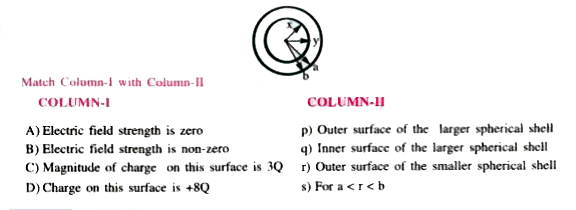A solid metallic sphere has a charge +3Q. Concentric with this sphere is a conducting spherical shell having charge −Q. The radius of the sphere is a and that of the spherical shell is b(b>a) What is the electric field at a distance R(a<R<b) from the centre
14πε0Qr
14πε03Qr
14πε03Qr2
14πε0Qr2
The correct Answer is:C
To determine the electric field at a distance R from the center of a solid metallic sphere with charge +3Q and a concentric conducting spherical shell with charge −Q, we can use Gauss's law.
1. Identify the Region: We need to find the electric field at a distance R where a<R<b. This means we are looking at a point that is outside the solid metallic sphere but inside the conducting spherical shell.
2. Use Gauss's Law: According to Gauss's law, the electric flux through a closed surface is equal to the charge enclosed divided by the permittivity of free space (ϵ0):
ΦE=Qencϵ0
where ΦE=E⋅A and A is the surface area of the Gaussian surface.
3. Choose a Gaussian Surface: We choose a spherical Gaussian surface of radius R (where a<R<b). The area A of this surface is given by:
A=4πR2
4. Determine the Enclosed Charge: Inside this Gaussian surface, the only charge that contributes to the electric field is the charge of the solid metallic sphere, which is +3Q. The charge on the conducting shell does not contribute to the electric field inside it.
5. Calculate the Electric Flux: The electric field E is uniform over the Gaussian surface, so we can express the electric flux as:
ΦE=E⋅A=E⋅4πR2
6. Set Up the Equation: From Gauss's law, we have:
E⋅4πR2=3Qϵ0
7. Solve for the Electric Field E:
E=3Q4πϵ0R2
Final Result:
The electric field at a distance R from the center of the sphere, where a<R<b, is given by:
E=3Q4πϵ0R2
ΦE=Qencϵ0
where ΦE=E⋅A and A is the surface area of the Gaussian surface.
A=4πR2
ΦE=E⋅A=E⋅4πR2
E⋅4πR2=3Qϵ0
E=3Q4πϵ0R2
The electric field at a distance R from the center of the sphere, where a<R<b, is given by:
E=3Q4πϵ0R2
Topper's Solved these Questions
- ELECTROSTATICSBOOK - RESONANCE ENGLISHCHAPTER - ELECTROSTATICSEXERCISE - Part- II
20 Videos
- ELECTROSTATICSBOOK - RESONANCE ENGLISHCHAPTER - ELECTROSTATICSEXERCISE - Part - IV
9 Videos
- ELECTROSTATICSBOOK - RESONANCE ENGLISHCHAPTER - ELECTROSTATICSEXERCISE - Part - III
20 Videos
- ELECTROMAGNETIC INDUCTIONBOOK - RESONANCE ENGLISHCHAPTER - ELECTROMAGNETIC INDUCTIONEXERCISE - A.l.P
19 Videos
- EXPERIMENTAL PHYSICSBOOK - RESONANCE ENGLISHCHAPTER - EXPERIMENTAL PHYSICSEXERCISE - PART -II
10 Videos
Similar Questions
A conducting sphere of radius R is charged to a potential of V volts. Then the electric field at a distance r(>R) from the centre of the sphere would be
View SolutionThe electric field at a distance 3R/2 from the centre of a charge conducting spherical shell of radius R is E. The electric field at a distance R/2 from the centre of the sphere is
View SolutionThe electric field at a distance 3R/2 from the centre of a charge conducting spherical shell of radius R is E. The electric field at a distance R/2 from the centre of the sphere is
View SolutionA solid metal sphere of radius R has a charg +2Q. A hollow spherical shell of radius 3R placed concentric with the frist sphere has net charge -Q.

What would be the final distribution of charges if the sphres are joined by a conducting wire
View SolutionA thin spherical conducting shell of radius R has a charge q. Another charge Q is placed at the centre of the shell. The electrostatic potential at a point P a distance R2 from the centre of the shell is
View SolutionA thin spherical conducting shell of radius R has a charge q. Another charge Q is placed at the centre of the shell. The electrostatic potential at a point P a distance R/2 from the centre of the shell is
View SolutionA hallow metal sphere of radius R is uniformly charged. The electric field due to the sphere at a distance r from the centre:
View SolutionA point charge +q is placed at the centre of a conducting spherical shell of inner radius a and outer radius b. Find the charge appearing on the inner and outer surface of the shell.
View SolutionIn Fig a conducting spherical shell of inner radius .x. and outer radius .y. is concentric with a larger conducting spherical shell of inner radius .a. and outer radius .b.. Inner shell has a total charge +3Q and the outer shell has a charge +5Q. Let r be the distance of any point from the common centre O.

View SolutionA small conducting spherical shell with inner radius a and outer radius b is concentric with a larger conducting spherical shell with inner radius c and outer radius d. The inner shell has total charge +2q, and the outer shell has charge +4q. (K=(1)/(4piepsilon_(0)))

Find the electric field in terms of q and the distance r from the common centre of the two shells for (i) b<r<c (ii) c<r<d
View Solution
